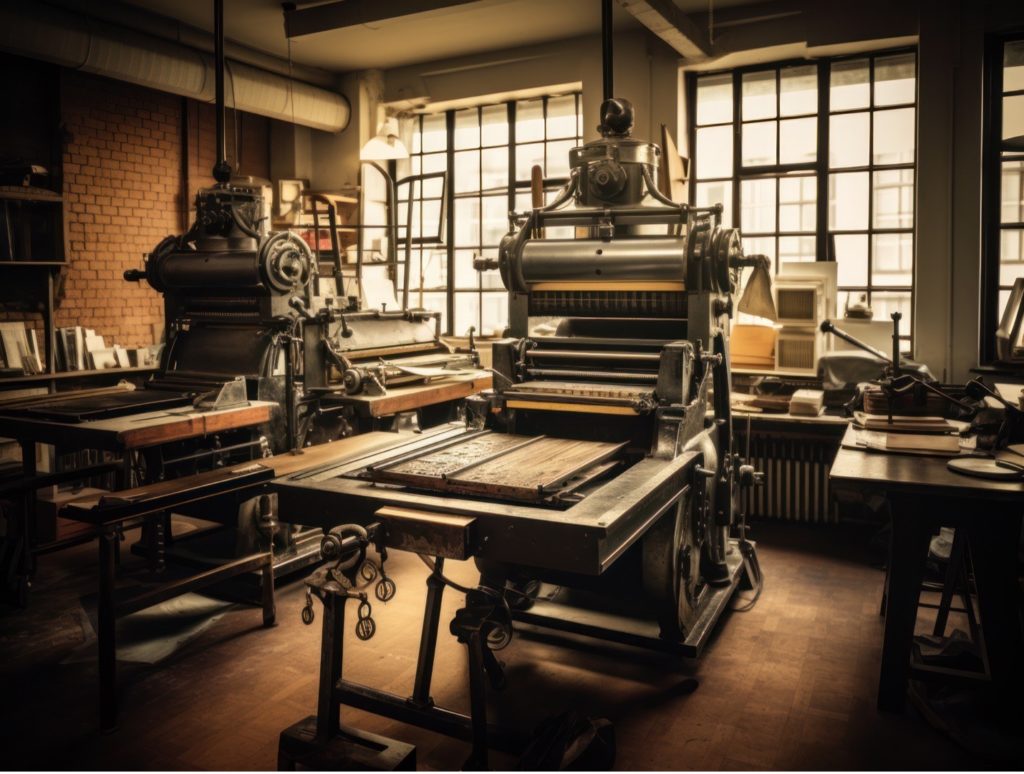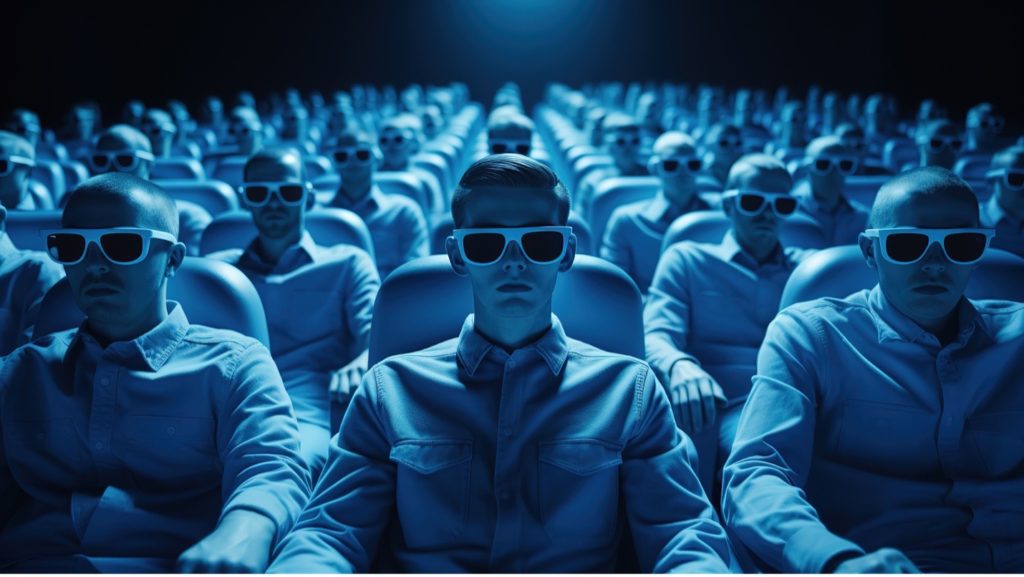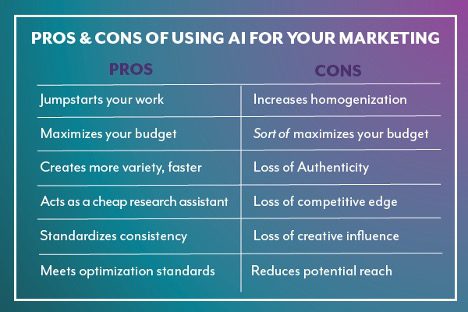Creating authentic communications through channels that matter
Artificial Intelligence (AI) has been the talk of 2023, prompting endless conversations about its impact on our world—especially concerning what it could do to the workforce. As brand marketers, we see it seeping into every facet of our space. A good marketer knows that all brand touchpoints must work cohesively to represent the whole, and that the toolkits we use to achieve this consistency morph constantly as technology advances. Now generative AI is the newest tool in our kit.
Before we dive in, keep in mind that AI isn’t really artificial intelligence at this point. Rather it’s computer-based algorithms that quickly churn out actions. So, don’t be fooled—AI is not all sunshine and rainbows here in the marketing realm. Read on to hear what we believe is the good, the bad and the honest truth.

Stock generated with AI
AI USE IN MARKETING: HARNESS WHAT’S GOOD
As marketing experts, we must stay privy to the ever-changing landscape in which we work. We’re in an industry that is both fast-paced and in high demand to help brands stay at the forefront of their audience’s conversations.
As we know, AI functions on data, algorithms and learning techniques which quite literally allow us to have the latest data and research at our fingertips. We see this in every facet of our work—from understanding the latest trends to share with our audiences, to easily implementing metadata or chatbots on websites and even automating design processes. And it all intertwines. All of the advanced technologies at our disposal promise a future where we can create seamless user experiences across the whole customer journey.

Stock generated with AI: Gutenberg’s Printing Press
Creatively Speaking
Creative problem solving has forced mankind to evolve, adapt, and become smarter. Throughout history, designers have adapted rapidly to ever-changing technology as evidenced by Illuminated manuscripts turning into woodblock carvings, only to become antiquated with the invention of Gutenberg’s printing press. Similarly, introduction of the computer followed by public internet access plunged us into a digital revolution that changed everything we knew about every aspect of business and communication. AI is just the next step in that evolution.
In general the functional use of AI in design helps fulfill the need for increased volume and speed—more variation, sizes, formats, quicker prototypes—required to get our ideas into a final visual output faster than ever before. It’s why trained designers who didn’t adapt to “self-made” publishing tools (e.g. Squarespace, Wix, Canva) that enable anyone to “design” quickly and cheaply have struggled to remain economically viable for many small businesses.
Strong design solutions rely on creativity, critical thinking, understanding nuances in subjectivity and intuition. They require a sense of empathy and emotional connection to their end user to solve unique problems. Since AI relies on data to make decisions based off information, it will currently struggle to meet the human component.
“To those who understand the complexities of communication, design, strategy and innovation, AI becomes nothing more than a way to systematize the portions of the process that are expendable to critical human thinking,” warns Creative Director Elyse Flynn “Even now many of the AI tools at our disposal are only as good as those who have learned how to communicate with them—a learned skill in and of itself.”

Digitally Speaking
The biggest contributions we’ve seen so far have come in the form of using customer data to present a more customized user experience. Currently we use AI to conduct research before writing content, to source keywords for metadata and to generate new ideas for content creation.
While AI is a useful tool for planning and ideation purposes and can be helpful for copywriting starts, we believe it’s important for humans to write all our copy, and plan to continue to do so in the future. Standing out and being authentic is still one of the most important aspects of brand marketing and will continue to be, no matter how evolved the tools become.
“While these thoughts are very young, we see them expanding quickly as CRMs develop applications that can accommodate and utilize the lightning-fast growth of AI-related products and associated APIs,” says Lead Web Developer Aaron Schaut.

We’re also seeing a lot of AI integration relating to small business needs on advertising platforms like Facebook, Instagram, Google and Mailchimp. Each has a keen understanding of what works and what doesn’t, and this is all based on trillions of data points leveraged into AI tools that can help small business maximize their budgets. By simply connecting these platforms to existing assets, we can draft ad copy, create A/B variants, generate imagery and launch campaigns, mostly with an acceptable level of quality and optimization.

“While this is all great, we still must engage the human touch to deal with complex nuances like audience targeting and budget deployment, and that’s where agencies like TIS come in,” suggests Digital Strategist Zachary Guy. “The combo of AI and agency offers a powerful punch of ability and budget optimization. A real win-win for small businesses.”
AI USE IN MARKETING: UNDERSTANDING LIMITATIONS AND WHAT’S AT RISK
Now, as good as AI is, us folks at TIS all came back to one very real concern: If we let AI take the reins, what happens to the human touch? Like we mentioned before, AI functions on data, algorithms and learning techniques. So, when everyone starts pulling from the same data, what happens? In a word: Homogenization.
Turning everything over to AI is a recipe for disaster when it comes to brands. Logos lose their character, brands lose their unique voice and websites lose their individualistic charm. How can you make an authentic brand if you take away the only thing bringing authenticity?

Stock generated with AI
AI USE IN MARKETING: AND THE HONEST TRUTH IS…
AI in this day and age will never be a replacement for the human-centered approach we all crave. AI will never have a heartbeat. It doesn’t have a mind of its own. It can’t foster real relationships with real people. It doesn’t have the emotional intelligence to understand the human struggle nor does it have the capacity to do the one thing us marketers aim to do for each client: Build an individualized brand that accurately represents who you are.
At TIS, we embrace AI strictly for the specific purposes where it can add value to our work for our clients. We urge anyone reading this to not be so consumed by it as to become one in a sea of sameness, but rather to be aware of these distinctions and use AI cautiously.
“At the end of the day, it always comes back to holistic strategy, says Copywriter and Content Strategist Devon Yousif. “AI may be great for the pieces and parts of your marketing mix, but it takes a real person to see the bird’s-eye view of how everything—from your brand identity to the actual words on a page to the execution—works together to create an authentic brand.”

Summary: AI is great tool to include in your toolkit, regardless of your discipline, but it will never replace the human experience, at least we’ll hope not in our lifetime.
Pros & Cons of Using AI for Your Marketing
Keeping in mind that at the time of this publication, AI simply cannot replace the human experience, here are some examples we’ve compiled of how nearly every good thing about AI also has a negative side, too.

- PRO: Jumpstarts and streamlines your work. In an instant we can brainstorm concepts using AI tools that give us a wide variety of ideas to vet in an instant. By inputting generic prompts and keywords, these tools can spit out factual content as well as help jumpstart layout options.
- CON: Increases homogenization. These layout options and copy generators work from generic prompts and keywords, requiring a human brain to vet, strategize and ensure the results align to brand voice and values. While some CRM integrations can write product content or create articles for social media that push directly to the web, for example, results vary depending on operator ability to customize the content in brand voice. It becomes obvious that a human curator only can ensure that the holistic strategy is implemented properly.
- PRO: Maximizes Your Budget. In many cases, a client can create their own AI-generated content and pass along to an agency like us for deployment which saves copywriting fees. Similarly, most design programs we use daily have integrated generative AI features that allow certain types of work to be streamlined. For example, Adobe Photoshop now uses Adobe Firefly to help add or remove content from certain images using various prompts and tools.
- CON: Sort of Maximizes Your Budget. While AI can streamline the work, we still need a human to adjust design elements so they will appear real to the naked eye, and edit language to ensure brand authenticity.
- PRO: Creates More Variety, Faster. Apps like FaceApp allow you to see photographs of people shown a hundred different ways with the click of a button. Apps such as Midjourney and DALL-E2 allow new, exciting worlds to be built using heavy prompt communication and editing, potentially changing the way we process image creation and curation.
- CON: Loss of Authenticity. Many AI generated images, especially those of living objects, share the same shiny, perfect, dead-in-the-eyes quality that remind one of the Stepford Wives. Everything appears normal until you look a little closer or at just the right angle.
- PRO: Acts as a Cheap Research Assistant. AI can serve as a cost-effective research assistant producing data via chatbot rather than sifting through endless pages of Google responses.
- CON: Loss of Competitive Edge. When everyone has access to the same tools, it becomes hard to gain an edge. Developing high-end prompts and asking the right questions in order to get unique answers matters a ton.
- PRO: Standardizes Consistency. Most AI-generated content is standardized as best practice which is good for consistency and accuracy across platforms. Specifically for websites, we see most value coming in the form of AI-generated draft copy, metadata and chatbots.
- CON: Loss of Creative Influence. Again, we lose the human touch and all the unique, individualized touches we bring, creating a world of homogeny.
- PRO: Meets optimization standards. While agencies that work on these platforms every day have this knowledge readily available, a small business running their own campaigns might feel like they are guessing or missing out. AI tools give you that peace of mind when you deploy your own content.
- CON: Reduces Potential Reach. AI places you firmly in the mix with everyone else, so you aren’t gaining an advantage. When you’re running a digital advertising campaign especially, the agent running your campaign brings a level of experience in human form that AI tools aren’t keeping up with. As you look at larger budget levels or campaigns that run over a period of time, this can mean thousands of dollars of difference. That can translate to thousands of customers being missed or not messaged appropriately. That’s a big deal when cost of customer acquisition is high or the lifetime value of your customers is worth a lot to your business.
An addendum to AI : 3/18/2024
It’s been a little over two months since our article was published on the Event Garde blog. With how quickly generative AI technology is progressing, we have a few additional thoughts to add that weren’t originally on the radar.
1. Generative Video: Companies like Pika and products like Sora (developed by OpenAI) have been pushing the envelope on text-to-video and idea-to-video capabilities. We’ve even seen the first hybrid AI/live action short film hit screens. We’ve come a long way from seeing a startling Will Smith slop up a plate of spaghetti and it seems that we won’t have a long way to go before a feature film incorporating AI is available to audiences. Particularly useful advances in this technology surround the ability to finely control animated movements and generate longer length clips. Generative AI video companies are also aware that the consistency of characters or aesthetic is an area that needs more development.
2. Custom GPTs: We’re still waiting with bated breath for the first truly compelling application of OpenAI’s GPT software in the world of custom bots. For now, it still appears to be limited to the basic text-to-image applications, assistive chatbots and coding support tools that were available initially. While tools like this are helpful, we don’t see them as proverbial “game changers” as they apply to the world of business. Until the need for human training, interaction with AI technology and outputs riddled with error are removed, we don’t see ourselves becoming a billion-dollar company of one.
3. Labor Changes: With all major technological advancements, the world of labor shifted significantly with the mass adoption of AI technology. Headlines of massive layoffs and labor union strikes have died down in recent weeks, but constant new developments mean more change is coming. Yes, ChatGPT has reduced the need for big companies to hire large teams of developers and in some cases, layoffs are due to competition from AI companies undercutting existing services, but the possibility of massive unemployment still seems to have limited potential in the near future. Although employers have expressed their predictions that workforce replacement is coming in the longer term.